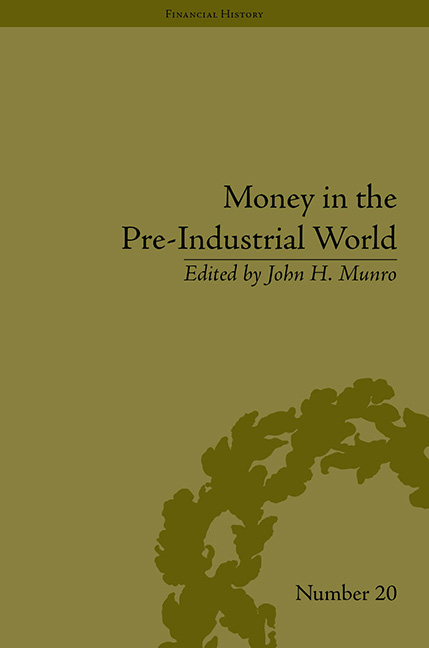Book contents
- Frontmatter
- CONTENTS
- List of Figures and Tables
- List of Contributors
- Introduction
- 1 The Technology and Economics of Coinage Debasements in Medieval and Early Modern Europe: with Special Reference to the Low Countries and England
- 2 From Aurelian to Diocletian: Financing Imperial Recovery by Coinage Debasements and Fiduciary Currencies
- 3 The Making of a Gold Standard: The Ducat and its Offspring, 1284–2001
- 4 Debasement of the Coinage and its Effects on Exchange Rates and the Economy: in England in the 1540s, and in the Burgundian-Habsburg Netherlands in the 1480s
- 5 The Amsterdam Wisselbank's Innovations in the Monetary Sphere: The Role of ‘Bank Money’
- 6 Silver in England 1600–1800: Coinage Outputs and Bullion Exports from the Records of the London Tower Mint and the London Company of Goldsmiths
- 7 The Burdens of Tradition: Debasements, Coinage Circulation and Mercantilist Public Policy Debates in Seventeenth-Century Aragon
- 8 Money or Export Commodity for Asia? American Silver in the Markets of Mexico, Castile and Amsterdam from the Sixteenth to the Eighteenth Century
- 9 Cacao Beans in Colonial México: Small Change in a Global Economy
- 10 Precious Metals, Debasements and Cowrie Shells in the Medieval Indian Monetary Systems, c. 1200–1575
- Notes
- Index
2 - From Aurelian to Diocletian: Financing Imperial Recovery by Coinage Debasements and Fiduciary Currencies
- Frontmatter
- CONTENTS
- List of Figures and Tables
- List of Contributors
- Introduction
- 1 The Technology and Economics of Coinage Debasements in Medieval and Early Modern Europe: with Special Reference to the Low Countries and England
- 2 From Aurelian to Diocletian: Financing Imperial Recovery by Coinage Debasements and Fiduciary Currencies
- 3 The Making of a Gold Standard: The Ducat and its Offspring, 1284–2001
- 4 Debasement of the Coinage and its Effects on Exchange Rates and the Economy: in England in the 1540s, and in the Burgundian-Habsburg Netherlands in the 1480s
- 5 The Amsterdam Wisselbank's Innovations in the Monetary Sphere: The Role of ‘Bank Money’
- 6 Silver in England 1600–1800: Coinage Outputs and Bullion Exports from the Records of the London Tower Mint and the London Company of Goldsmiths
- 7 The Burdens of Tradition: Debasements, Coinage Circulation and Mercantilist Public Policy Debates in Seventeenth-Century Aragon
- 8 Money or Export Commodity for Asia? American Silver in the Markets of Mexico, Castile and Amsterdam from the Sixteenth to the Eighteenth Century
- 9 Cacao Beans in Colonial México: Small Change in a Global Economy
- 10 Precious Metals, Debasements and Cowrie Shells in the Medieval Indian Monetary Systems, c. 1200–1575
- Notes
- Index
Summary
Given the extent to which so many of the world's economies have suffered from excessive issues of fiat paper money and consequent inflations, often drastic, since the First World War and the end of the traditional gold standard, the coinage debasements in the Roman world during the third century ad should appear to be quite relevant to modern society. Yet, the great debasement of imperial Roman silver coins, along with the accompanying price increases during this era, has attracted little attention among current scholars of Antiquity. Debased silver or billon coins, especially the antoniniani of 238–74 ad, and the silver-coated coins struck between 274 and 371 – for almost a century – produced serious inflations that ruined traditional classes, while enriching much of the Roman autocracy and its servants. A destructive expedient at best, these debasements led to a breakdown not only of the currency but of fiscal institutions and monetary policy. Hence this inflation was once seen as a step backwards: a destruction of a well-developed, monetized market economy and a consequent shift to a ‘natural’ or barter economy (Naturwirtschaft) that marked the transition from the traditional Classical world to that of Late Antiquity. More recently, however, scholars have devoted far less attention to such questions of debasement and inflation, and have instead directed their primary efforts to quantifying the Roman economy. But the results are far from conclusive. There are insufficient data for, and even less agreement on, estimates of the GDP of the Roman Empire or even the scale of annual production of silver currency in the late first and second centuries. The economy of the Rome under the Principate has also been compared, with varying degrees of success, to those of the traditional agrarian empires of Han China, Mughal India and the Ottoman Middle East. Furthermore, social historians, writing in the tradition of M. I. Finley, have regarded coins as fiscal instruments issued to meet imperial expenditures rather than to promote markets and trade in what has sometimes has been dubbed an underdeveloped economy.
- Type
- Chapter
- Information
- Money in the Pre-Industrial WorldBullion, Debasements and Coin Substitutes, pp. 33 - 44Publisher: Pickering & ChattoFirst published in: 2014



